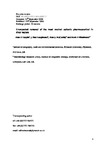Unexpected removal of the most neutral cationic pharmaceutical in river waters
| dc.contributor.author | Fitzsimons, Mark | |
| dc.contributor.author | Tappin, Alan | |
| dc.contributor.author | McCarthy, AJ | |
| dc.contributor.author | Loughnane, JP | |
| dc.date.accessioned | 2016-10-10T13:13:49Z | |
| dc.date.accessioned | 2017-01-13T10:14:35Z | |
| dc.date.issued | 2016-09-22 | |
| dc.identifier.issn | 1610-3661 | |
| dc.identifier.issn | 1610-3661 | |
| dc.identifier.uri | http://hdl.handle.net/10026.1/8241 | |
| dc.description.abstract |
Contamination of surface waters by pharmaceuticals is now widespread. There are few data on their environmental behaviour, particularly for those which are cationic at typical surface water pH. As the external surfaces of bacterio-plankton cells are hydrophilic with a net negative charge, it was anticipated that bacterio-plankton in surface-waters would preferentially remove the most extensively-ionised cation at a given pH. To test this hypothesis, the persistence of four, widely-used, cationic pharmaceuticals, chloroquine, quinine, fluphenazine and levamisole, was assessed in batch microcosms, comprising water and bacterio-plankton, to which pharmaceuticals were added and incubated for 21 days. Results show that levamisole concentrations decreased by 19 % in microcosms containing bacterio-plankton, and by 13 % in a parallel microcosm containing tripeptide as a priming agent. In contrast to levamisole, concentrations of quinine, chloroquine and fluphenazine were unchanged over 21 days in microcosms containing bacterio-plankton. At the river-water pH, levamisole is 28 % cationic, while quinine is 91–98 % cationic, chloroquine 99 % cationic and fluphenazine 72–86 % cationic. Thus, the most neutral compound, levamisole, showed greatest removal, contradicting the expected bacterio-plankton preference for ionised molecules. However, levamisole was the most hydrophilic molecule, based on its octanol–water solubility coefficient (Kow). Overall, the pattern of pharmaceutical behaviour within the incubations did not reflect the relative hydrophilicity of the pharmaceuticals predicted by the octanol–water distribution coefficient, Dow, suggesting that improved predictive power, with respect to modelling bioaccumulation, may be needed to develop robust environmental risk assessments for cationic pharmaceuticals. | |
| dc.format.extent | 455-465 | |
| dc.language | en | |
| dc.language.iso | en | |
| dc.publisher | Springer Science and Business Media LLC | |
| dc.relation.replaces | http://hdl.handle.net/10026.1/6495 | |
| dc.relation.replaces | 10026.1/6495 | |
| dc.subject | Levamisole | |
| dc.subject | Quinine | |
| dc.subject | Chloroquine | |
| dc.subject | Fluphenazine | |
| dc.subject | Persistence | |
| dc.subject | River | |
| dc.title | Unexpected removal of the most neutral cationic pharmaceutical in river waters | |
| dc.type | journal-article | |
| dc.type | Journal Article | |
| plymouth.author-url | https://www.webofscience.com/api/gateway?GWVersion=2&SrcApp=PARTNER_APP&SrcAuth=LinksAMR&KeyUT=WOS:000388105000004&DestLinkType=FullRecord&DestApp=ALL_WOS&UsrCustomerID=11bb513d99f797142bcfeffcc58ea008 | |
| plymouth.issue | 4 | |
| plymouth.volume | 14 | |
| plymouth.publication-status | Published | |
| plymouth.journal | Environmental Chemistry Letters | |
| dc.identifier.doi | 10.1007/s10311-016-0582-2 | |
| plymouth.organisational-group | /Plymouth | |
| plymouth.organisational-group | /Plymouth/Faculty of Science and Engineering | |
| plymouth.organisational-group | /Plymouth/Faculty of Science and Engineering/School of Geography, Earth and Environmental Sciences | |
| plymouth.organisational-group | /Plymouth/REF 2021 Researchers by UoA | |
| plymouth.organisational-group | /Plymouth/REF 2021 Researchers by UoA/UoA07 Earth Systems and Environmental Sciences | |
| plymouth.organisational-group | /Plymouth/Research Groups | |
| plymouth.organisational-group | /Plymouth/Research Groups/BEACh | |
| plymouth.organisational-group | /Plymouth/Research Groups/Marine Institute | |
| plymouth.organisational-group | /Plymouth/Users by role | |
| plymouth.organisational-group | /Plymouth/Users by role/Academics | |
| plymouth.organisational-group | /Plymouth/Users by role/Researchers in ResearchFish submission | |
| dcterms.dateAccepted | 2016-09-12 | |
| dc.rights.embargodate | 2017-9-22 | |
| dc.identifier.eissn | 1610-3661 | |
| dc.rights.embargoperiod | 12 months | |
| rioxxterms.funder | Natural Environment Research Council | |
| rioxxterms.identifier.project | Bacterial Assimilation of Riverine Organic Nitrogen (BARON). | |
| rioxxterms.versionofrecord | 10.1007/s10311-016-0582-2 | |
| rioxxterms.licenseref.uri | http://www.rioxx.net/licenses/under-embargo-all-rights-reserved | |
| rioxxterms.licenseref.startdate | 2016-09-22 | |
| rioxxterms.type | Journal Article/Review | |
| plymouth.funder | Bacterial Assimilation of Riverine Organic Nitrogen (BARON).::Natural Environment Research Council | |
| plymouth.funder | Bacterial Assimilation of Riverine Organic Nitrogen (BARON).::Natural Environment Research Council |


